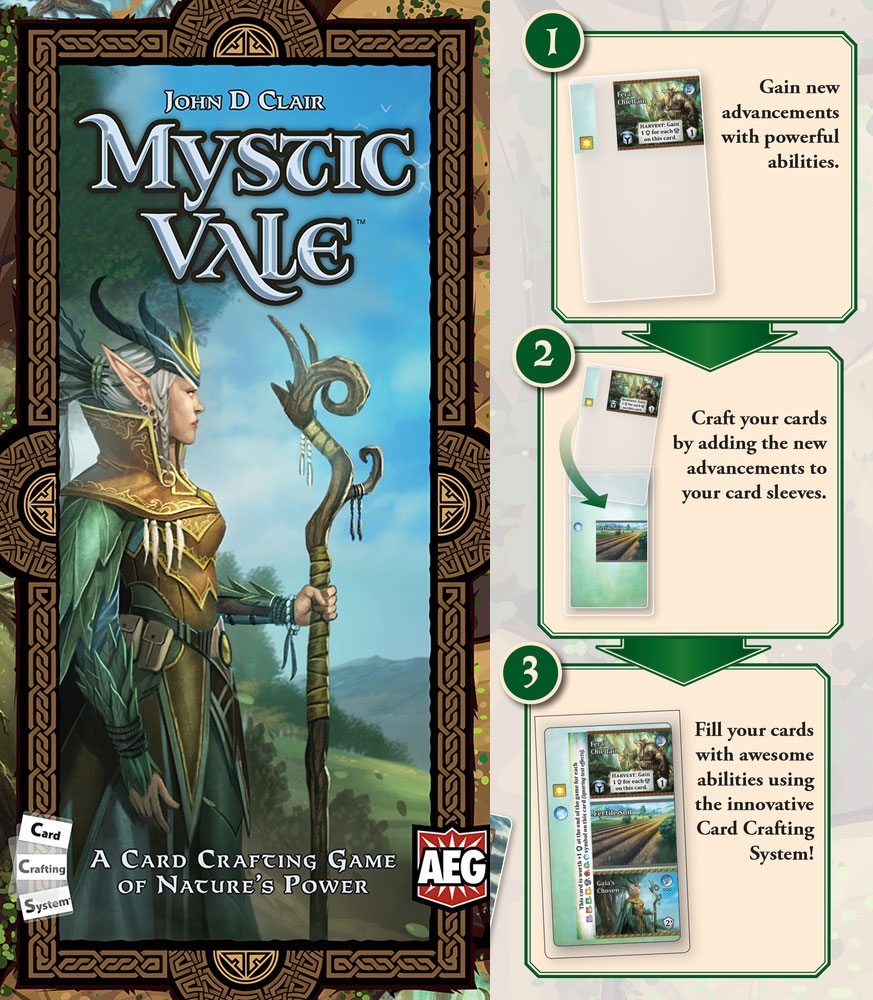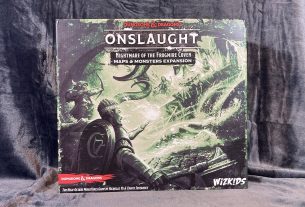One of AEG’s new releases this year introduces a new gaming concept: the Card Crafting System, which uses transparent cards to build up a card piece by piece. In Mystic Vale, you and your opponents will attempt to restore the Valley of Life, cursed by a wicked king.
At a glance: Mystic Vale is a game by John D. Clair for 2 to 4 players, ages 14 and up, and takes about 45–60 minutes to play. It retails for $44.99 and should be in stores next week; Amazon has it for pre-order now. (I believe the official release is at Gen Con in August.) I think the game could be played by kids younger than 14, particularly if they have some experience with deck-building games; there is nothing thematically inappropriate.
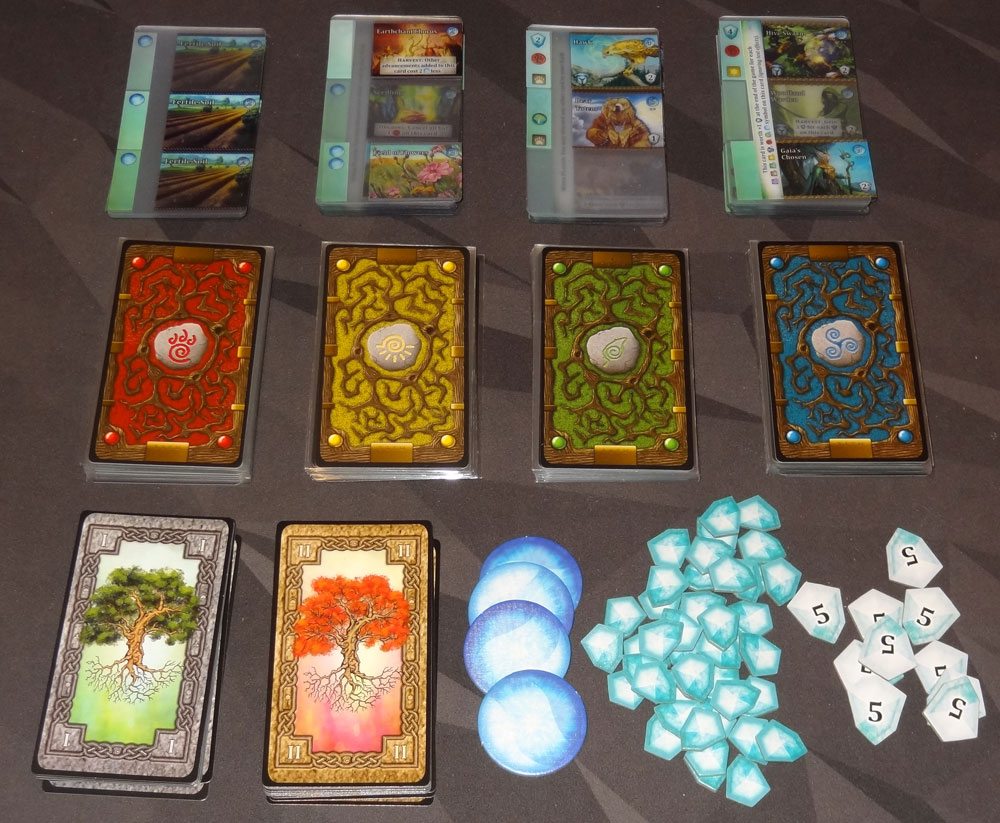
Components:
- 80 starting cards (20 each for 4 players)
- 96 Advancement cards:
- 33 Level 1
- 30 Level 2
- 33 Level 3
- 18 Fertile Soil Advancement cards
- 36 Vale cards:
- 18 Level 1
- 18 Level 2
- 4 Reference cards
- 54 VP tokens (in denominations of 1 and 5)
- 4 Mana tokens
- 100 card sleeves

The advancement cards are tarot-sized, long and rectangular, and made of transparent plastic. Each one has an illustration (an “advancement”) that covers one third of the card–top, middle, or bottom—along with some other text and symbols. There are a few that also include a narrow band of text running vertically near the left edge. There’s a note included that says that the plastic cards actually have a very thin plastic film on top of them that’s meant to be removed—think of the clear coating on the screens of your electronic devices—but that it’s easier to remove after the cards have been handled for a while, so it’s not necessary to peel them all off before you begin. Also, there’s a warning not to leave your cards in a hot vehicle, because the plastic cards could get damaged by extreme heat. I also noticed that the game smells a little weird—it’s a different smell than the “new print” smell of other games—but I assume this smell will dissipate now that the game’s been opened.

The rest of the cards—the starting cards and vale cards—are regular cardstock, though I did find that the cardstock seems a little thinner than some of AEG’s usual cards. For the starting cards, it makes sense because you’ll need to fit up to three plastic cards into a sleeve with them, but it does mean that you need to be careful shuffling the vale cards. Some of the starting cards also have some advancements on them, and some are entirely blank.

The tokens are all nice, sturdy cardboard, easy to punch out. The mana tokens are really huge, but you won’t lose them. It’s nice that the game includes 100 sleeves—you’ll only need 80 of them, but this way you have some extras. Before you begin, you will need to sleeve the 80 starting cards.
Overall, the components are a fairly nice quality, but the legibility of the cards isn’t great. Each of the advancement cards has a mana cost to purchase, marked in a blue circle in the corner of the advancement illustration. However, it’s a white number on a swirly light blue, and it is hard to read even from fairly close up.
There are also some strange design choices: some cards have spirit symbols, which are used to purchase the vale cards. These are shown as colored squares with a lighter symbol on the vale cards (for the cost) and on the advancement cards (for generating spirit symbols to use). However, some of the vale cards also have effects that provide more spirit symbols to spend, and these are not square—instead, it’s just the symbol itself, without the square. It’s not clear why there’s an alternate symbol in some places, when making it consistent would make it more obvious how many of each you had. Another is that the Fertile Soil advancement cards have a Level 1 mark on them, but they actually do not get shuffled into the Level 1 deck.

How to Play
You can download a PDF of the rulebook here.
The object of the game is to score the most victory points: some points are harvested during the game, and some points are awarded only at the end of the game based on advancement and vale cards you have acquired.
To set up, give each player a set of 20 starting cards and a mana token. (One mana token has a star on one side, in case you want to randomize starting player.) Create a pool of VP tokens based on the number of players. Set out the various decks of cards: Fertile Soil cards, advancement cards in 3 levels, and vale cards in 2 levels. You’ll use all of the cards except the Level 1 advancements: these are shuffled and a deck is created based on the number of players. Flip over the top 3 advancements of each level, and the top 4 vale cards of each level.
At the beginning of the game, each player will prepare their starting field—this is the same thing as the Prep Phase that usually happens at the end of your turn. You turn the top card over on top of your deck—this is the “on-deck” card. Then, you move the on-deck card to the right of your deck, into your “field,” then turn over a new on-deck card. You repeat this process until there are three Cursed Lands showing—two in your field and one on-deck. Your mana token starts out face-down (grey).
Your turn has four phases: Planting, Harvest, Discard, and Prep.
Planting: This is the press-your-luck portion of the game. If you ever have 4 decay symbols showing between your field and on-deck card, your field is spoiled and you don’t get to harvest. (You start with 9 Cursed Lands in your deck, which each provide 1 mana and 1 decay.) You get to decide whether to push or pass. To push, you play your on-deck card into your field, resolving any “when played” abilities on it, and then turn over the next on-deck card. If you haven’t spoiled, you continue, again choosing to push or pass.

If you spoil (by having 4 decay symbols showing), you discard all of your field cards (not the on-deck card). Flip your mana token to the blue side as a consolation—that can be spent as 1 mana on any future turn by flipping it back to the grey side. There are also green “growth” symbols on some cards, which cancel out decay symbols.
Harvest: If you pass before you spoil, then you harvest. The left edge of the cards have various symbols: mana, points, and spirit symbols. In addition, some advancements have other harvest abilities printed on them. During the harvest phase, you can activate any of these and buy cards in any order. Mana you collect may be spent to buy advancement cards—whatever is not spent is lost at the end of your turn. Spirit symbols can be used to purchase vale cards, which are placed in front of you and do not get shuffled into your deck. If you have points to harvest, you take VP tokens from the pool. Each turn, you may buy up to 2 advancements and 2 vales. Note: you do not get the abilities of advancements and vales on the turn that you purchase them.
Fertile Soil is a basic advancement that simply provides 1 mana, and if you purchase one of these you may pick from the deck whichever position you want—top, middle, or bottom—as long as it is available.
Discard: First, sleeve any advancements you purchase. They must be put into cards in your field, and they must go in a position that does not cover an existing advancement. Then, you place all of your field cards (not the on-deck card) into your own discard pile to the left of your deck. Finally, you replenish the advancements and vales. Note: if a deck of advancements runs out, you replenish from the next level up.

Prep: While you do your Prep phase, the next player can begin their turn. You basically do the setup again: play your on-deck card, turn over a new on-deck card, and repeat until there are three or more decay symbols showing, and then stop.
The game end is triggered when the pool of VP tokens runs out. Play will continue until everyone has had the same number of turns, and if you harvest more VP during this time, use extra tokens from the box.
Once the game ends, everyone totals their points: add up all of the grey VP icons on your advancements and vales, and then add in the VP tokens you’ve acquired. Ties are broken by the number of Level 3 advancements and Level 2 vales added together.
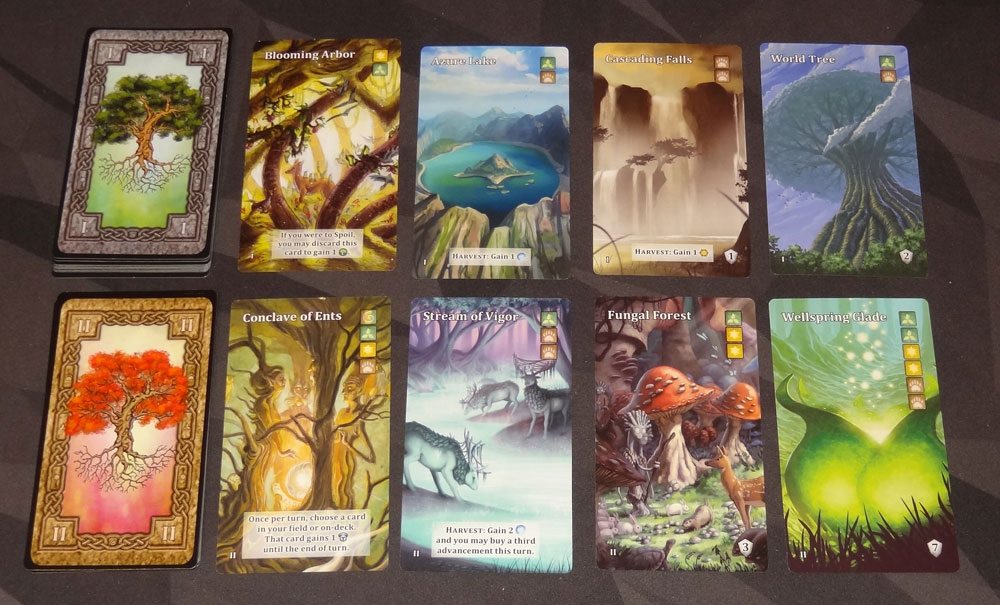
The Verdict
Mystic Vale is a curious mix: the mechanics seem familiar, but the transparent cards change the way things work, opening up new possibilities for tabletop gaming. Now, transparent cards themselves aren’t totally new. Plastic playing cards with see-through bits have been around for a while, and there are a couple of games that make use of them, most notably Gloom. Swish is another example from a few years ago, but I don’t know of too many more. However, this is probably the first game in which the transparent cards are combined to form a single card that can be played, rather than having stacks of transparent cards on the table.
The deck-building mechanic is pretty similar to others you’ve played: you earn a certain amount of currency each turn (in this case, mana) which can be spent to purchase new cards, and then you forfeit anything you don’t spend. Buying cards improves your deck, ideally generating both points and more income on future turns so you can purchase even better cards. The press-your-luck mechanic is atypical in deck-building games: instead of drawing a set number of cards, you can push to try to get more mana, but you might bust and end up with nothing. (Flip City uses this press-your-luck mechanic as well.) One tactic in Mystic Vale is to purchase cards that can mitigate the decay, decreasing your chances of spoiling each turn so it’s safer to push.
I’ve played a couple of games of Mystic Vale with different sets of players, and the reaction has been mixed: some really enjoyed the card-crafting aspect, and some felt that it was gimmicky and that the gameplay itself wasn’t compelling enough. I’ll address some of the strengths and weaknesses of the game.

One of the biggest complaints for this particular set of cards is that there isn’t any direct player interaction, which bothers some players more than others. Your cards do not directly affect other players—everything you play only affects you—so it’s a little like playing Dominion without any of the Attack cards mixed in, and is the reason critics refer to some deck-building games as “multiplayer solitaire.” However unlike Dominion, you are able to affect players indirectly by buying cards that they want: there are limited numbers of each type of card, so if you buy one, then you deny somebody else from getting it. I imagine that if the game is successful enough to produce expansions, we’ll see a new mix of card abilities, including some direct attacks on other players, but at least for now there isn’t any. The indirect effects are much greater in a 4-player game than a 2-player game, of course, because you can only buy 2 advancements per turn. In a 4-player game, it can be hard to plan your moves ahead of time because the market may have changed significantly by the time it’s your turn.
The legibility I’ve already addressed in the “Components” section, but generally it feels like the UI could have been improved a bit. Some of the issues will be less of a problem after you’re familiar with the game, but I don’t think you’ll memorize all of the card prices and those are the hardest to read.
Another complaint that has come up in my groups is that the game feels like it ends too soon. Like other deck-builders, Mystic Vale feels like it’s about building up an engine. You build your deck so that you can get more mana or points or spirit symbols so that you can buy even more powerful cards. But by the time the game ends, you will most likely still have some entirely blank cards that haven’t even gotten started yet, and you’ll feel like “I just got this thing going!” I’m ambivalent on this one: if you want to extend the game, it’s actually very easily done by just adding more VP tokens into the pool—there are plenty extra. However, I also think that, in general, it’s better to have a game end come sooner than you expect than later. A game that ends before you’re ready means you wanted to play some more; a game that ends well after you thought it should have means you wanted to stop a while ago. But I also had the same feeling the first few times I played, that I really wanted to see some of my well-crafted cards come into play a couple times. It’s quite likely that some of your fully-crafted cards (with three advancements) won’t ever get played before the game ends.
The length of the game, however, is also driven somewhat by the players. Some cards will award points during your Harvest phase, but not all of them. If all of the players are buying those advancements, the VP pool runs out sooner, and the game ends sooner. However, if players are focusing on other cards (like those that give more end-game points), then the VP pool will last longer, and you may get around to playing more of your fully-crafted cards.
There’s not much rubber-banding, either—that is, there’s no real catch-up mechanic. At the beginning, very few people can afford the higher cost cards, so everyone is building up. But if you don’t get to the point where you can afford more expensive cards and other people are buying them, you will fall behind. Eventually, it may even get to the point where the cheaper cards are exhausted and all that’s left is the higher cost cards.
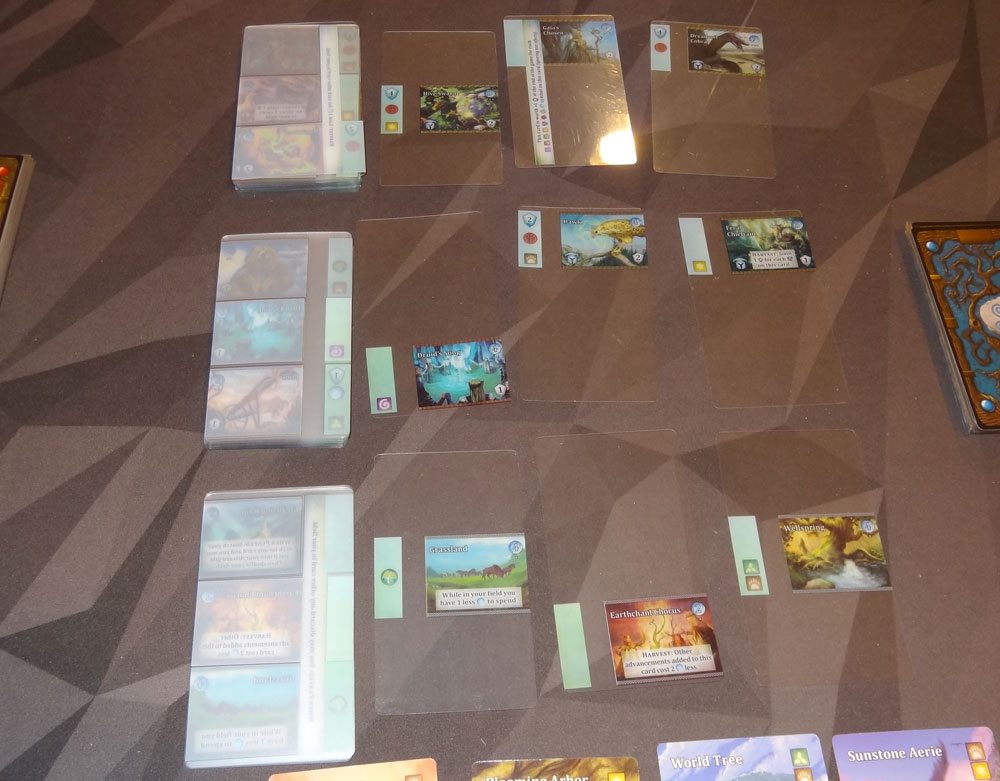
One final note: because the cards are transparent, there is some information that would typically be hidden info that is no longer totally hidden. For instance, when you look at the stacks of advancement cards, you may be able to see the first few advancements, depending on whether the positions overlap or not. Granted, you’re looking at the mostly white backing of the illustration, but you can see a little bit of the color through it, and once you’re familiar with the illustrations you could probably tell what’s coming up next if you were so inclined. Also, it’s pretty easy to tell by feel whether a sleeved card has no advancements or several advancements. A less scrupulous player could use that info to decide whether to pass or push.
Okay, moving on to what I liked about it: I did think it was pretty fascinating that it’s a deck-building game where your deck always has exactly 20 cards in it. You never remove anything, and when you add advancements they don’t increase the number of cards you have. It takes a little getting used to that idea.
The card-crafting does seem a little gimmicky, but I like the gimmick. Upgrading and combining cards is the sort of thing that would be really easy to do in a digital game, but presents a lot of logistical challenges in a physical game, and I appreciate the ingenuity that went into making it work.
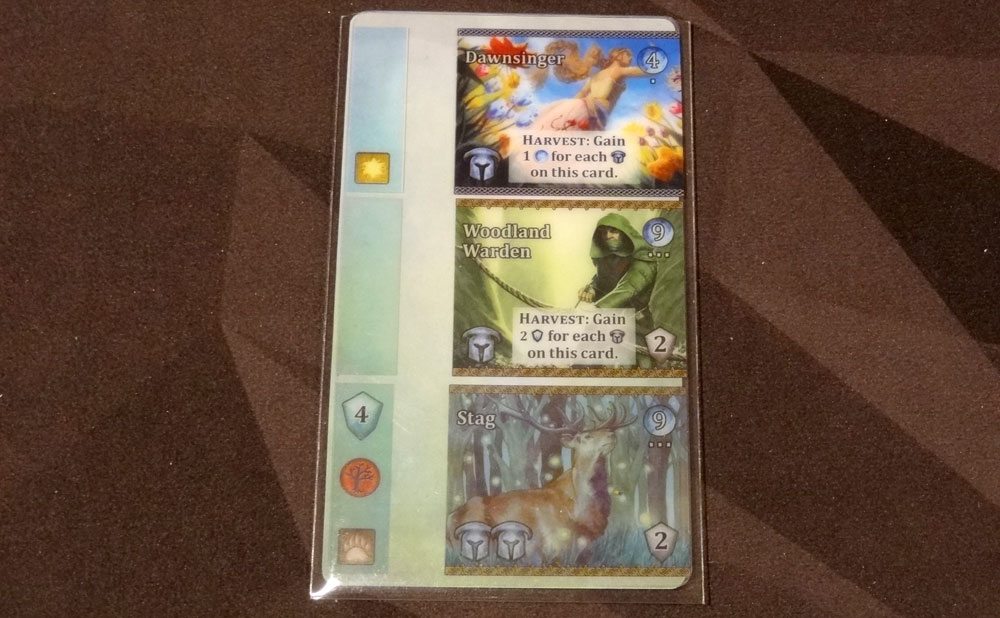
I’ve always liked deck-building games, and I like seeing new ways to put the mechanic to work. Mystic Vale is definitely a new sort of deck-builder. You assemble combinations that will work together on a single card, and trying to decide where to put new advancements when purchased becomes part of the strategy. There are some advancements that have “guardian” symbols on them, and some that have abilities based on how many guardian symbols are on the entire card. Figuring out how to get those advancements onto the same card is a tricky puzzle. Unlike a regular deck-builder, where you buy cards and hope that you’ll be able to draw those combinations in a single hand, in this case you need to have the right card in your field when you buy the combo—otherwise those two advancements will never end up on the same card.
It’s also interesting that, since you can only place an advancement in a blank position, that sometimes you can’t buy the card you want even when you have enough mana. You might end up pushing, not for more mana, but for more empty spaces on your cards—or you might push to get closer to playing your crafted cards, deciding that it’s worth risking if it gets you closer to reshuffling.
The game itself is pretty easy to teach: the one part that tends to confuse new players is the on-deck card (and remembering not to discard it), but overall the mechanics themselves are familiar. In that sense, it does feel like an introductory game, one that gets you the basics of a new type of gameplay but doesn’t necessarily feel extremely deep. I may be wrong, of course: sometimes there are strategies and tactics that are discovered only after you play many times. I do know, at least from the plays I’ve had so far, that you can win without buying any Vales at all, but sometimes the Vales can also be a deciding factor in the final score.
The theme itself feels secondary to the gameplay: there are Cursed Lands that cause decay, and Fertile Soil that provides mana, and a bunch of things that are sort of magical and nature-themed.
I do know that AEG is investing more into the Card-Crafting System, because there’s a teaser for another game at the back of the rulebook that also uses transparent cards, though from the images shown I can see that it does not use the same icons and functions as Mystic Vale. It looks to be a dungeon crawl of some sort, and the only similarity seems to be that the cards are also divided into thirds vertically. I’m very interested to see how else the Card-Crafting System will be used. I can imagine all sorts of other abilities that wouldn’t make sense in regular deck-building games, like the ability to move advancements from one card to another, or cards that might cover up or add symbols on other advancements.
Overall, I think Mystic Vale is notable as a new type of game. I think it’s fun, but there’s also room for improvement. If you like deck-building games and trying out new mechanics, give it a shot!
Disclosure: I received a review copy of this game.
